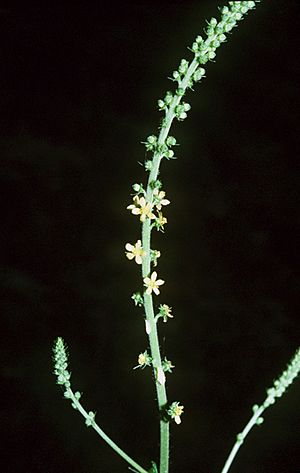Agrimonia parviflora facts for kids
Quick facts for kids Agrimonia parviflora |
|
|---|---|
 |
|
| Scientific classification | |
| Genus: |
Agrimonia
|
| Species: |
parviflora
|
Agrimonia parviflora is a type of flowering plant that lives for many years. It's a herbaceous plant, meaning it has soft stems instead of woody ones. In the United States, people often call it Small-flowered agrimony, harvestlice agrimony, swamp agrimony, or just harvestlice.
This plant belongs to the Rosaceae family, which is also known as the rose family. There are about fifteen different kinds of Agrimonia plants around the world. Seven of these kinds grow naturally in the United States. Most Agrimonia plants have small yellow flowers and large leaves. Out of all the fifteen types, harvestlice is sometimes seen as a troublesome plant.
What is Small-flowered Agrimony?
Agrimonia parviflora can grow quite tall, sometimes up to 6 feet! It has long, thin roots that can reach 6 inches into the ground. This plant stands upright and grows quickly, with many stems.
Flowers and Leaves
In the middle of summer, harvestlice plants produce many small yellow flowers. Some plants can have as many as 100 flowers! Each yellow flower has 5 petals and 5 to 10 stamens (the parts that make pollen). The flowers are tiny, about one-fourth of an inch across. They grow in a long cluster.
The plant makes fruit and seeds in the summer. Then, in the fall, it starts to die back. The fruit is small, about 4–5 mm long, and green. The stems are a bit fuzzy. The main leaves are smooth on top and slightly fuzzy underneath. These leaves are compound, meaning they are made up of smaller leaflets. Each leaf can have up to 17 main leaflets. These leaflets are shaped like a spear with jagged edges. You can also find smaller leaflets in between the main ones, and they also have jagged edges.
How Does it Spread?
The fruit of the harvestlice plant is like a bur. This means it's designed to stick to things! It spreads by hitching rides on the fur of mammals or the feathers of birds. The fruit usually holds just one seed. These seeds are tough and can survive through the winter.
Plant Interactions
Bees and some flies like to drink the nectar from the flowers. However, most animals, like mammals and reptiles, avoid eating this plant. This is because it has a bitter taste. Interestingly, some birds use harvestlice to build their nests. The plant's smell and bad taste help keep away predators and tiny pests like lice and mites from the nests.
Where Does it Grow?
Agrimonia parviflora likes places that are moist and wet. You can find it in swamps, woodlands, open fields called prairies, and even in ditches along roads. This plant loves full sunlight. It can grow in most types of soil, including sandy or silty ground. Because it often grows in wet areas, it's sometimes called swamp agrimony.
Locations
You can find this plant across Ontario, Canada. It also grows in 32 of the 50 United States. Along the Atlantic coast, harvestlice is found from Georgia up to New York. However, it's not very common in the flat coastal areas. It also grows as far west as Texas and South Dakota. If people grow these plants, they don't need much care. Harvestlice can even survive very cold weather, down to -33°F, and short periods of flooding.
Protecting the Plant
In the state of Connecticut, harvestlice is listed as a Special Concern species. This means there are worries about its future there. In Massachusetts, it's even listed as Endangered, which means it's at high risk of disappearing from that state. However, in the main parts of its range, Agrimonia parviflora is generally common.
How People Use It
Native American groups, like the Cherokee people, have used Agrimonia parviflora for a long time. The bur-like fruits of the plant could be used to help with diarrhea and to lower fevers. The root of the harvestlice plant could be crushed up and used for several health purposes. These included helping to increase red blood cells, aiding digestion, treating certain skin problems like pox, and as a dietary helper.

